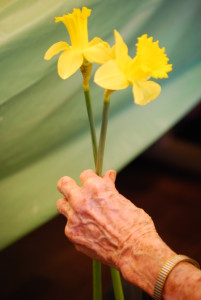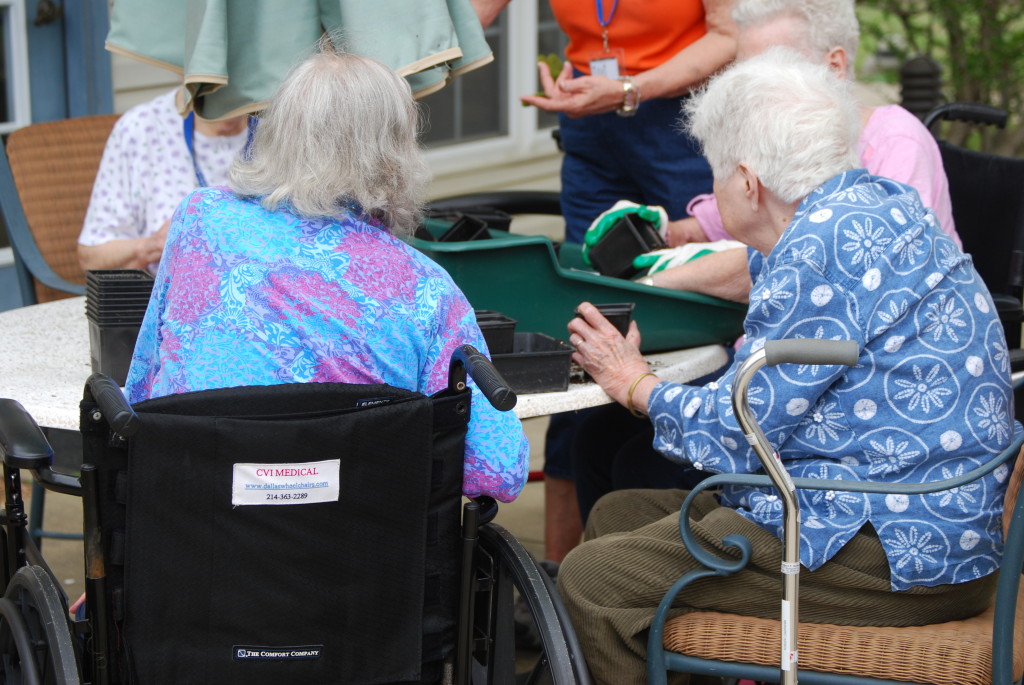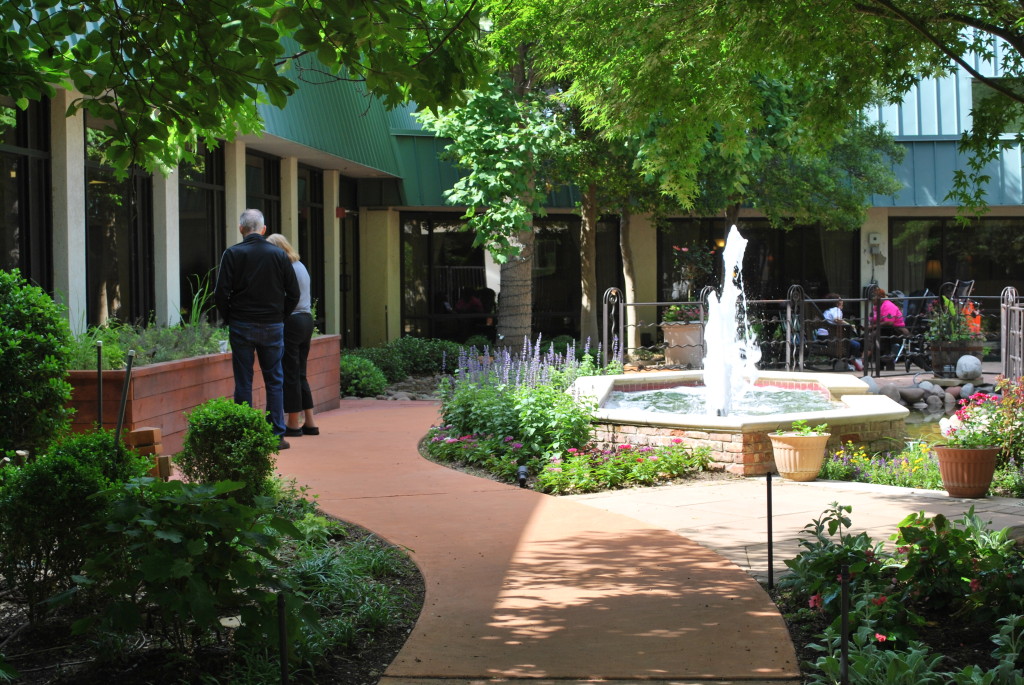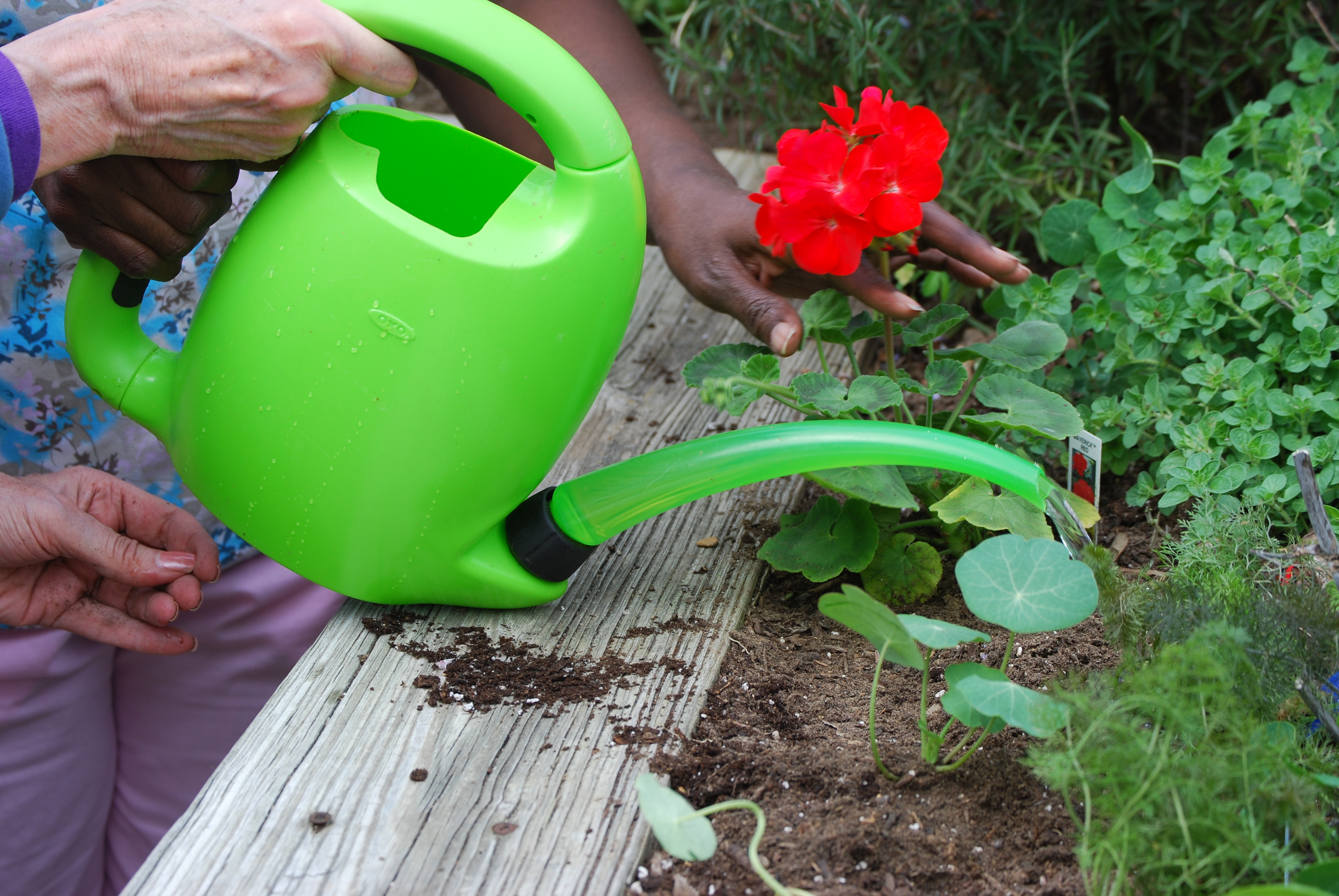Taking advantage of the beautiful spring weather, I have been bringing my elder groups outdoors as much as possible lately. We have been busy gardening in raised beds and sowing seed.
The act of going outdoors can be a bit challenging sometimes. I work mostly in residential facilities and find that some individuals aren’t inclined to go outdoors, even if they are physically and medically able. Some prefer to stay indoors where they feel more comfortable. At one of my client locations, residents are less inclined to go outdoors if they see a waving flag on the flagpole just outside the main hall window. Regardless of the time of year, they naturally think that it must be “cold out there.” So in these circumstances, I employ different strategies to gently encourage clients outdoors.
It is my goal to have clients choose to come outside into the garden with us. And not be taken there. Sometimes I am able to monitor this, sometimes not.
And when clients arrive in the garden, I encourage everyone to get involved, in one way or another. Some people have no interest in working directly at the garden beds. However, they may be enticed to work at tables or other areas adjacent to the garden. As a result, I have employed the following methods to engage clients wherever they choose to be.
Getting Outdoors
 Extend the olive branch. When approaching individuals before a session, I often bring a flowering plant, colorful watering can, a package of seed (which I often shake when entering the room and talking with people), or other visually interesting object with me and use that as a physical invitation to join the group outdoors. They can get an idea of the task at hand, with the visual and the verbal reinforcing each other.
Extend the olive branch. When approaching individuals before a session, I often bring a flowering plant, colorful watering can, a package of seed (which I often shake when entering the room and talking with people), or other visually interesting object with me and use that as a physical invitation to join the group outdoors. They can get an idea of the task at hand, with the visual and the verbal reinforcing each other.
Be descriptive about today’s activity. As necessary, I elaborate on the activity and use descriptive language to outline the Who, What, When, Where, and Why – the people who are involved, what tasks we intend to accomplish and why, the plants to be worked with, a description of today’s weather and seasonal interests, and so on. Outline the role that you hope they will fill in helping the group achieve the specific goal.
Provide reassurance of assistance. Reassure hesitant individuals that there are others there to help – this reassurance is essential for those who may not have prior gardening experience or lack the confidence to participate. So I might say, “Here [offering the individual the desirable object used as a physical invite], would you like to help us in the garden? We could really use your help and support. We’re getting our garden open for the spring, and I would appreciate your help to plant these beautiful geraniums.” I respond with additional information as necessary.
 Still hesitant? “Come and keep us company.” For some, just getting outside is an accomplishment. A simple invitation to “just come and sit with us” is often the trick to entice someone outdoors. And more often than not, these individuals see others having fun and doing different tasks, and then want to participate themselves. Or, they simply do just want to come and sit with the group. And I’m grateful for that too.
Still hesitant? “Come and keep us company.” For some, just getting outside is an accomplishment. A simple invitation to “just come and sit with us” is often the trick to entice someone outdoors. And more often than not, these individuals see others having fun and doing different tasks, and then want to participate themselves. Or, they simply do just want to come and sit with the group. And I’m grateful for that too.
If at first you don’t succeed…loop back around. After bringing others outdoors, go back and check in with individuals who originally didn’t want to go outside. They might want to come outside now that they see everyone else out there!
Sometimes there are individuals who can’t be enticed outdoors, no matter what you do or say. With the nature and goals of my programs, that is ok. I respect each individual’s right to make that choice. And, during my next visit, I will extend the same invitation and hope they will come then.
Once Outdoors
So clients have made the decision to join us outdoors. Since I like to give them the ability to make choices about what they can do while outside, I prepare additional activities when appropriate, aside from planting or tending directly to the garden. Some clients don’t want to do those activities, so I strategize about other relevant tasks and make these alternatives available. (Note: I have agency staff and volunteers assist during sessions and employ these strategies when practical.)
 Sowing seed – Think ahead and plan for future plantings. Have clients work together at a table to prepare soil and plant seeds for future gardening activities.
Sowing seed – Think ahead and plan for future plantings. Have clients work together at a table to prepare soil and plant seeds for future gardening activities.
Grooming plants – Show clients how to deadhead and groom plants that are to be or already are planted in the garden. Engage them in conversation and encourage them to make observations about the plants being tended and the garden itself.
Organizing and cleaning pots – When planting, I hand empty pots to clients who love organizing or appreciate a challenge. Organizing and stacking pots is like working a puzzle, so make sure to provide encouragement and direction as appropriate.
 Watering plants or filling up the birdbath – Some individuals view working with water as less “dirty” or easier than other gardening activities. I see it as another opportunity for sensory stimulation, social interaction (working in partnership with those who are planting), and working motor skills.
Watering plants or filling up the birdbath – Some individuals view working with water as less “dirty” or easier than other gardening activities. I see it as another opportunity for sensory stimulation, social interaction (working in partnership with those who are planting), and working motor skills.
 Touring the garden and making observations – Some individuals want to enjoy the sunshine and walk around the garden. Or some clients are agitated and don’t want to be around people. If possible, make an assignment to locate a favorite plant or see how the bird’s nest full of eggs is progressing, and have a friend or staff member go with that person to explore together. Jot observations in a notebook or pick a flower to tuck behind your ear.
Touring the garden and making observations – Some individuals want to enjoy the sunshine and walk around the garden. Or some clients are agitated and don’t want to be around people. If possible, make an assignment to locate a favorite plant or see how the bird’s nest full of eggs is progressing, and have a friend or staff member go with that person to explore together. Jot observations in a notebook or pick a flower to tuck behind your ear.

